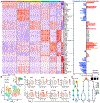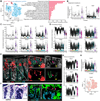An intercrypt subpopulation of goblet cells is essential for colonic mucus barrier function
- PMID: 33859001
- PMCID: PMC8542866
- DOI: 10.1126/science.abb1590
An intercrypt subpopulation of goblet cells is essential for colonic mucus barrier function
Abstract
The intestinal mucus layer, an important element of epithelial protection, is produced by goblet cells. Intestinal goblet cells are assumed to be a homogeneous cell type. In this study, however, we delineated their specific gene and protein expression profiles and identified several distinct goblet cell populations that form two differentiation trajectories. One distinct subtype, the intercrypt goblet cells (icGCs), located at the colonic luminal surface, produced mucus with properties that differed from the mucus secreted by crypt-residing goblet cells. Mice with defective icGCs had increased sensitivity to chemically induced colitis and manifested spontaneous colitis with age. Furthermore, alterations in mucus and reduced numbers of icGCs were observed in patients with both active and remissive ulcerative colitis, which highlights the importance of icGCs in maintaining functional protection of the epithelium.
Copyright © 2021 The Authors, some rights reserved; exclusive licensee American Association for the Advancement of Science. No claim to original U.S. Government Works.
Figures








Comment in
-
Intercrypt goblet cells - the key to colonic mucus barrier function.Nat Rev Gastroenterol Hepatol. 2021 Jul;18(7):455. doi: 10.1038/s41575-021-00460-2. Nat Rev Gastroenterol Hepatol. 2021. PMID: 33948022 No abstract available.
References
-
- Ermund A, Schutte A, Johansson ME, Gustafsson JK, Hansson GC, Studies of mucus in mouse stomach, small intestine, and colon. I. Gastrointestinal mucus layers have different properties depending on location as well as over the Peyer's patches. Am. J. Physiol Gastrointest. Liver Physiol 305, G341–G347 (2013). - PMC - PubMed
Publication types
MeSH terms
Substances
Grants and funding
LinkOut - more resources
Full Text Sources
Other Literature Sources
Molecular Biology Databases

